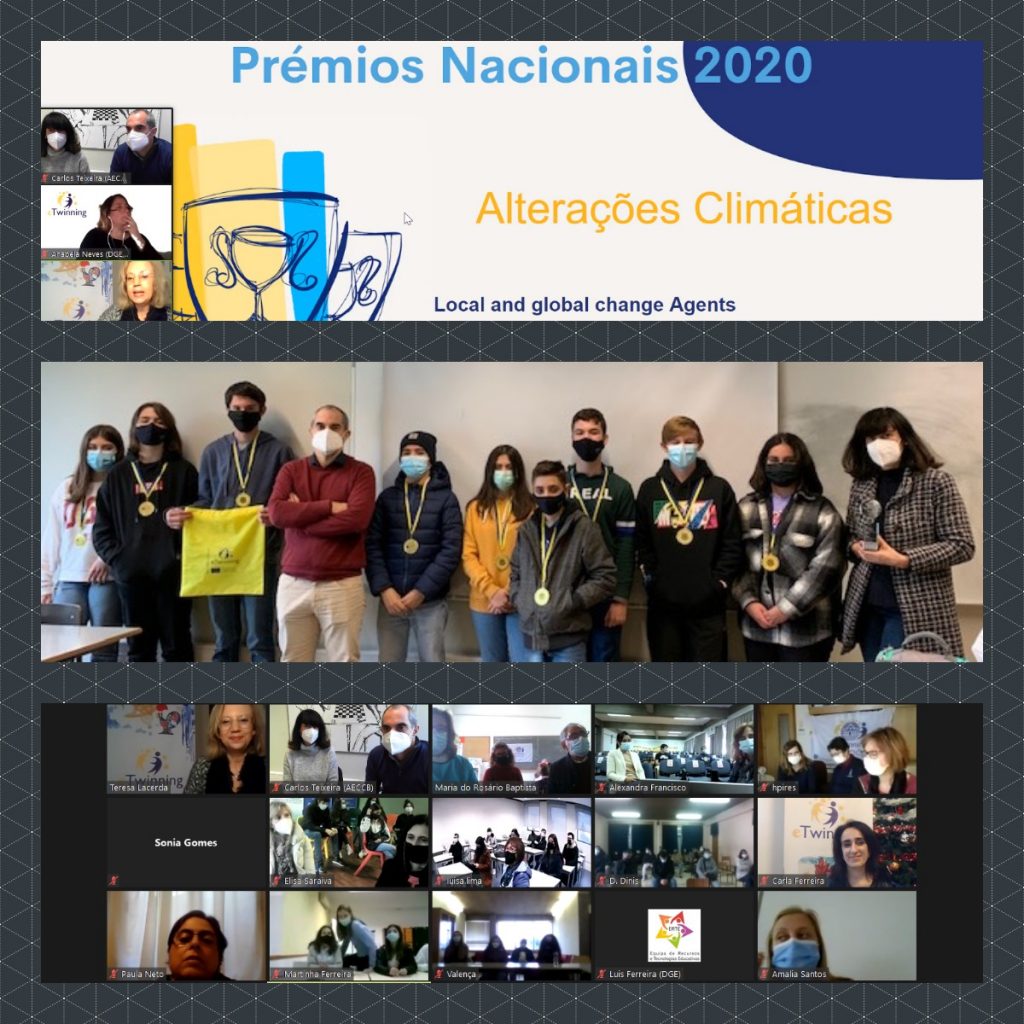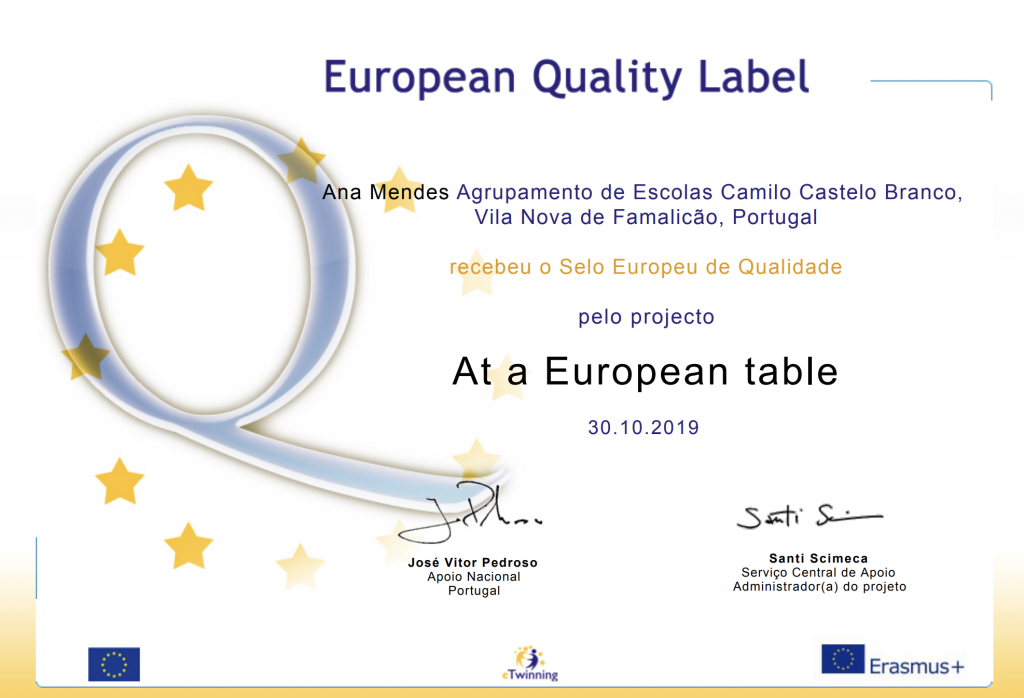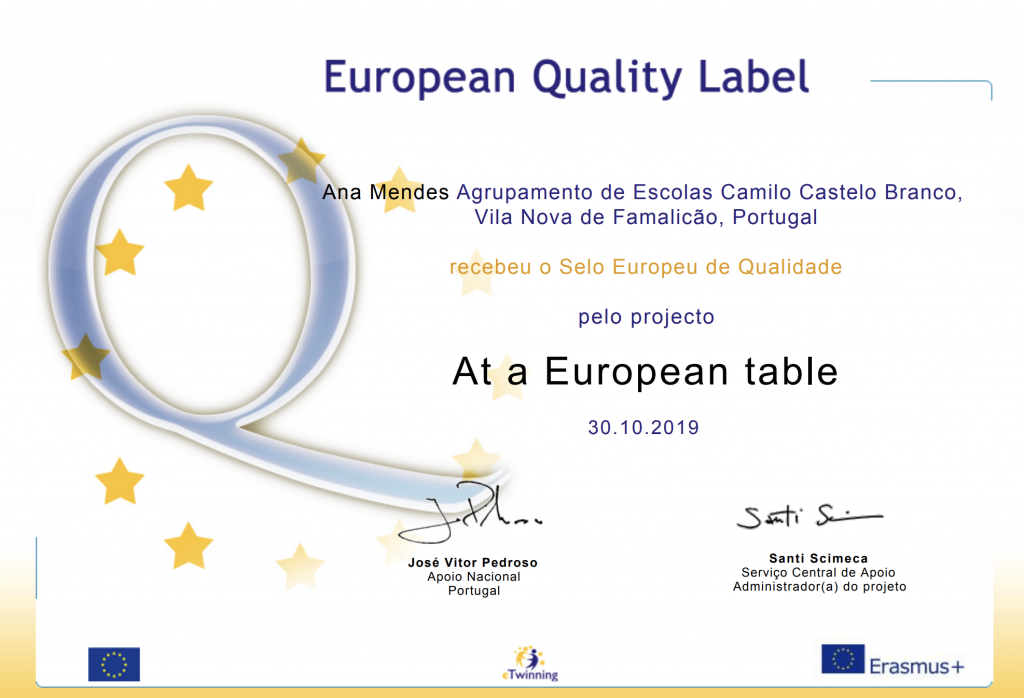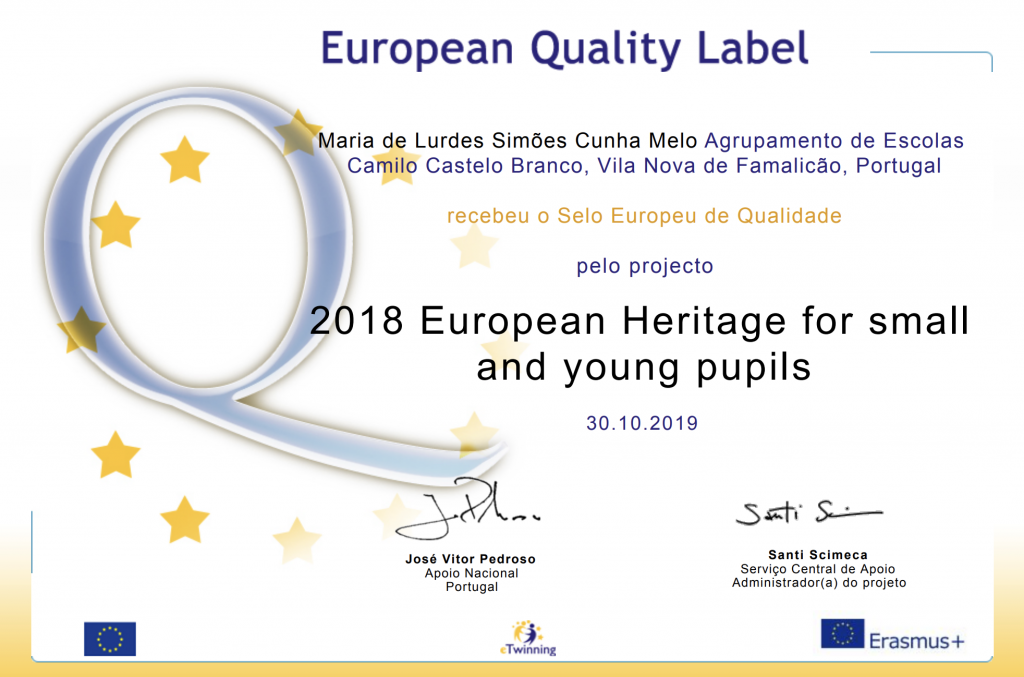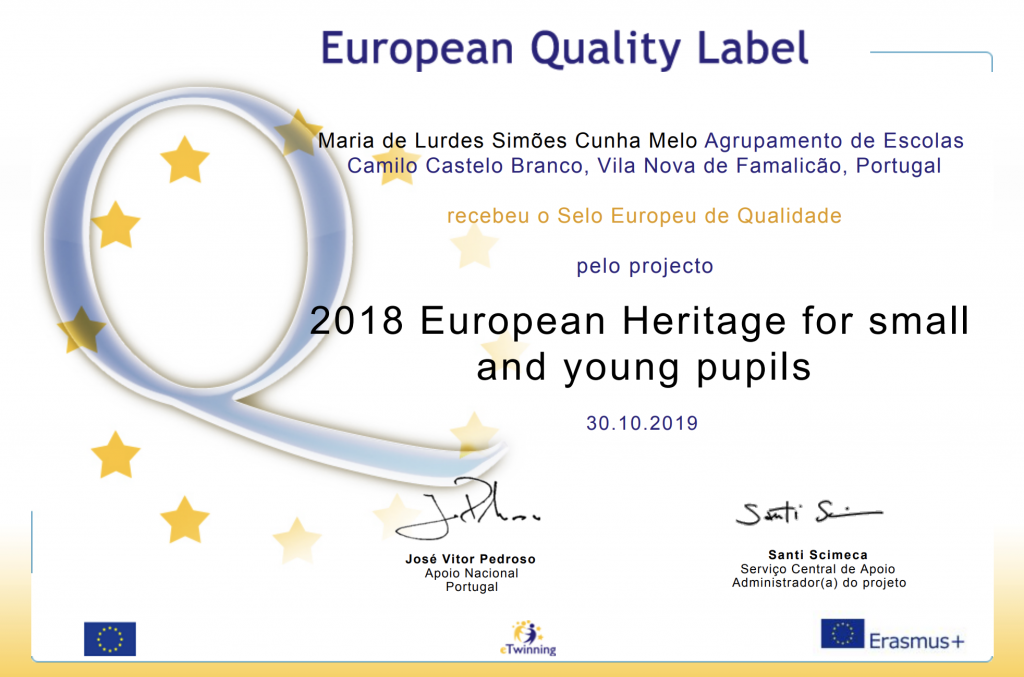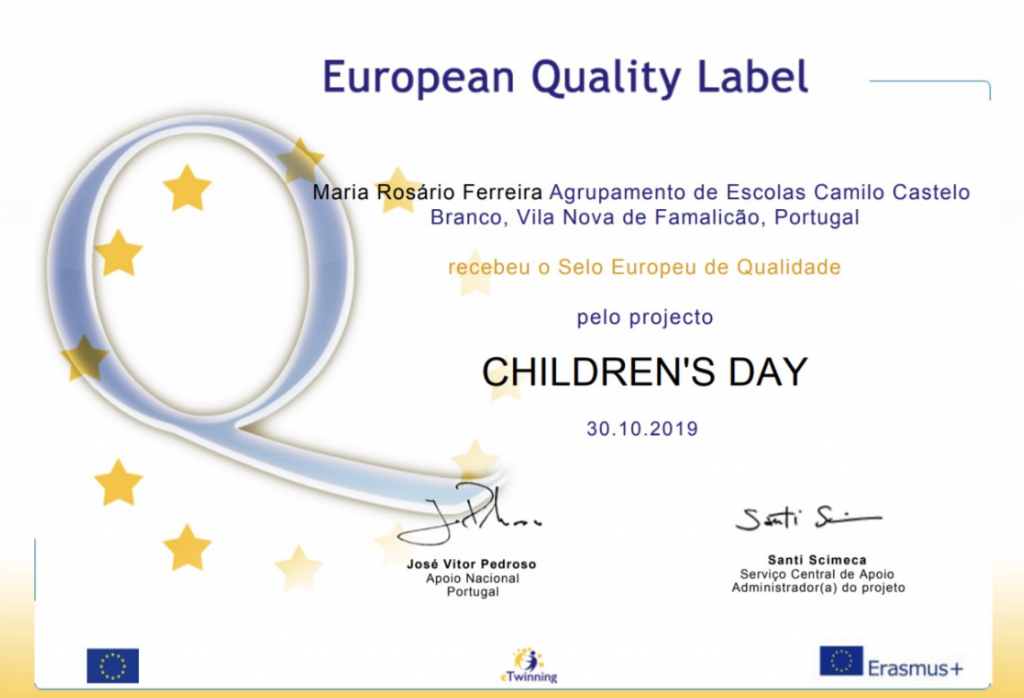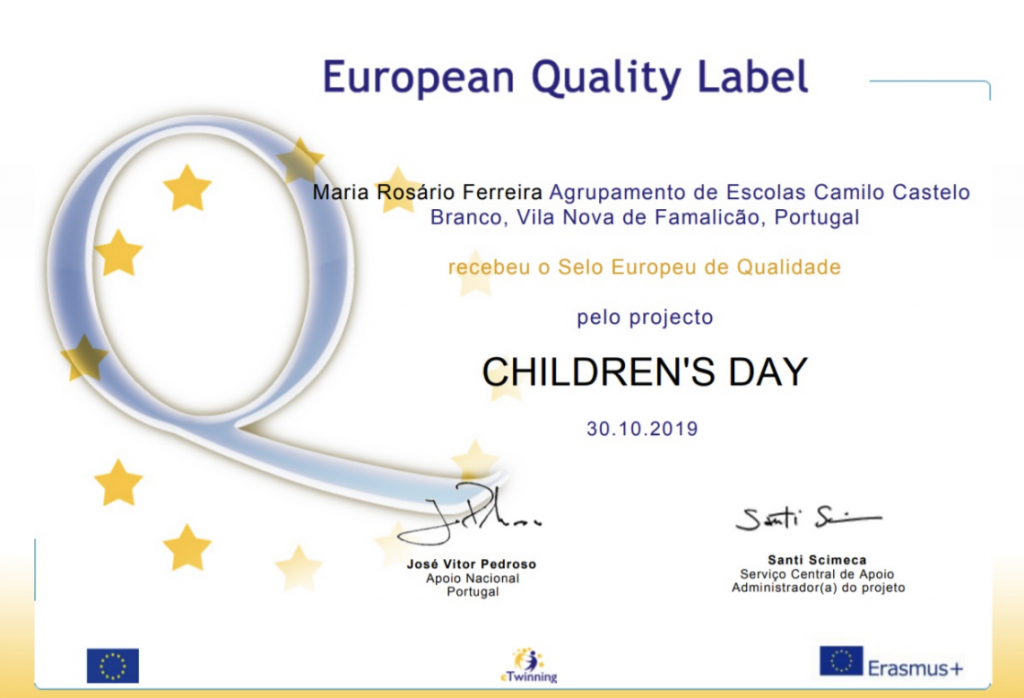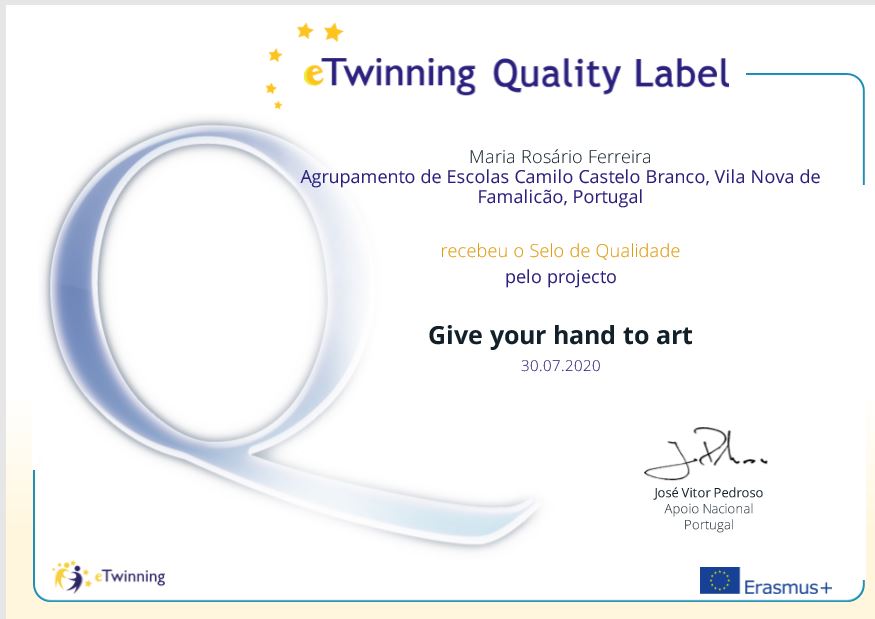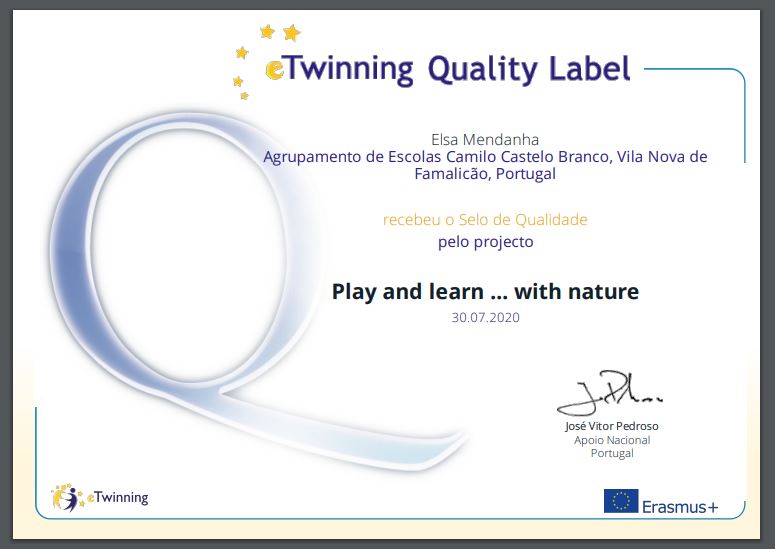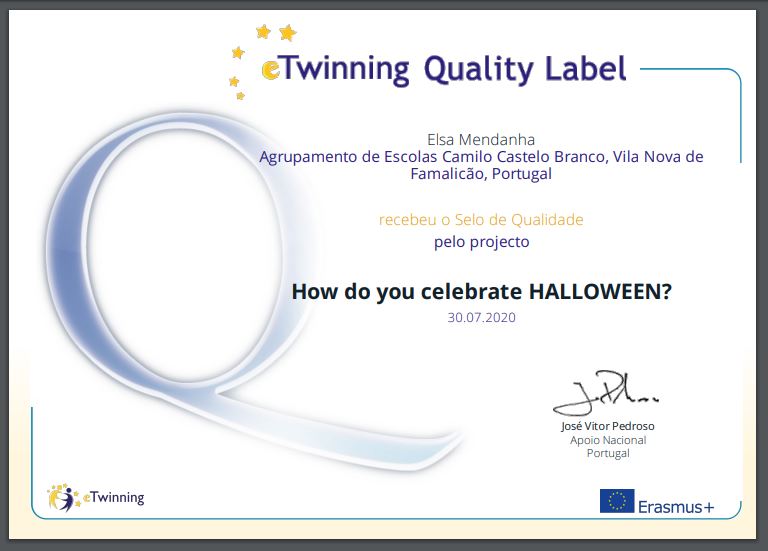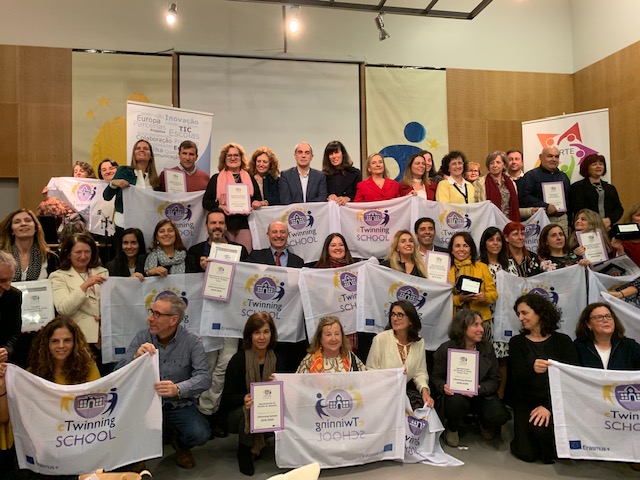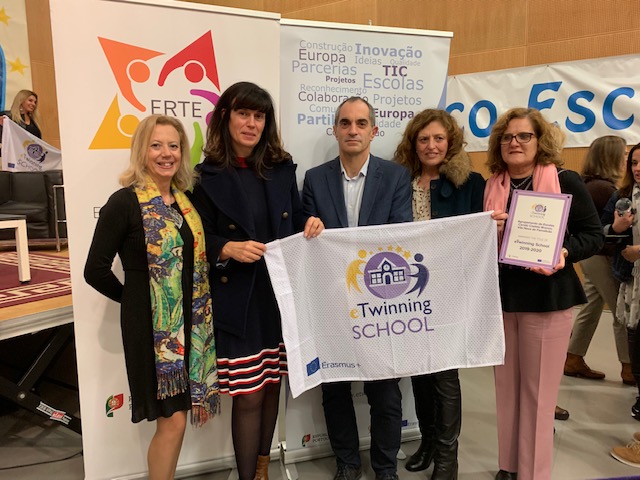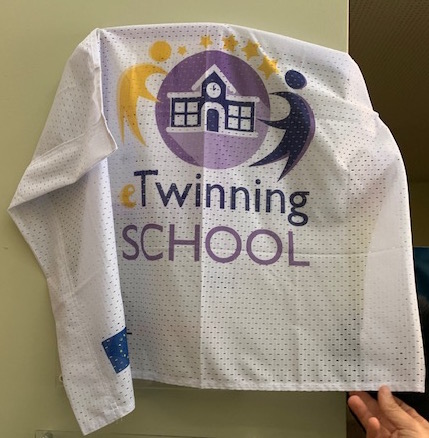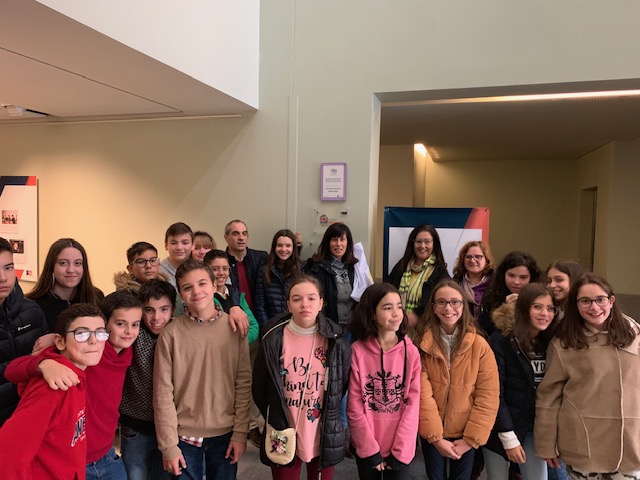Acessos: 5
Projetos Ativos, janeiro 2021
WE LEARNİNG WITH EDUCATIONAL ACTIVITIES IN SPECİAL EDUCATION: NEW NORMAL
https://twinspace.etwinning.net/128527/home

Acts of Kindness/Peacejam
https://twinspace.etwinning.net/131483

COVID # 19 STAY HOME
Helping Parents and Teachers not be Stressed
https://twinspace.etwinning.net/113904/home

Through Gesture and Sound: Unity in Diversity
https://twinspace.etwinning.net/128883

“A Change Is Gonna Come”
https://twinspace.etwinning.net/126422/home

Pollinating Insects
https://twinspace.etwinning.net/119260/home

MY CULTURE IS VALUABLE (MY CV)
https://twinspace.etwinning.net/118325/home

The world is ours!
https://twinspace.etwinning.net/117054/home

Creative readings
https://twinspace.etwinning.net/106782

PLANT A TREE, FREE YOUR SOUL
https://twinspace.etwinning.net/96919/home

TAKE PRECAUTION, END THE DANGER
https://twinspace.etwinning.net/140500/home

EPAS – Network of schools across the European Union to learn about European Parliamentary democracy and European citizenship
https://twinspace.etwinning.net/114504

Play and learn in nature 2
https://twinspace.etwinning.net/125766

Acessos: 0
Prémio Nacional eTwinning 2020
Local and global change Agents – Categoria Alterações Climáticas
O Trabalho dos alunos Local and Global Change Agents, orientado pela professora Ana Mendes, foi distinguido a com o Prémio Nacional eTwinning, na Categoria Alterações Climáticas.
http://www.famalicaoeducativo.pt/_premio_nacional_etwinning_2020_veio_para_o_aeccb
Os alunos do 9º12 da disciplina de Educação Moral e Religiosa Católica do Agrupamento de Escolas Camilo Castelo Branco foram os vencedores do Prémio Nacional eTwinning 2020, na categoria do ano – Alterações Climáticas, com o projeto “Local and global change Agents”. O Serviço Nacional de Apoio eTwinning, integrado na Direção-Geral de Educação, e a rede portuguesa de embaixadores, anunciaram o prémio no dia 2 de novembro e parabenizaram os vencedores.
Trata-se de um projeto inovador com metodologias ativas na qual os alunos trabalharam colaborativamente com escolas nacionais e europeias consolidando e aplicando conhecimentos que permitiram construir pontes que nos unem na abordagem da Educação para a Sustentabilidade Global. A integração curricular fez-se com a articulação interdisciplinar dos conteúdos de Educação Moral e Religiosa Católica da unidade temática: ”Ecologia e Valores”, Ciências e Clube do Ambiente. Sendo a questão das alterações climáticas um problema global, a resolução do problema passa pela responsabilidade individual de cada um de nós, já que a colaboração de todos é que trará soluções visíveis, ou seja, atitudes ecológicas capazes de garantir a sobrevivência das gerações futuras na Terra, que não se limitam à proteção do ambiente natural, mas também à sua preservação.
No final do projeto, todos os envolvidos se tornaram mais proativos, tornando-se agentes de mudança em prol do meio ambiente. Com este projeto contribuímos para os 17 Objetivos do Desenvolvimento Sustentável, no que diz respeito ao objetivo 4, 6 e 13.
A cerimónia de entrega dos prémios vai decorrer online no dia 15 de dezembro.
Acessos: 3
Selo Nacional de Qualidade // Selo Europeu de Qualidade 2020
Selo Europeu de Qualidade
Selo Nacional Qualidade
Acessos: 6
Projetos Encerrados, janeiro 2021
What is the world telling us?!

About the project
Have we ever wondered: What if the world talks? The world around us is alive. In this project we will talk about concepts such as ecology, environmental pollution, recycling and a land conservation. Our students will observe, write, paint about the environmental impact of the modern society. With our actions we influence the water we drink, the air we breathe, the soil in which we plant our food, the sea we swim in, the fish we eat, the animals we grow on our farms, the flowers that we smell on the trees that give us oxygen. What would we say if asked: What are you doing to make the world more beautiful and vibrant in the future? We want to hear in this project what the world is saying to us. We want our students to develop a environmental awareness. We are convinced that in this project our students will become environmentalists. Together we will develop a caring attitude towards nature in our children and their families. We will learn to appreciate waste and participate in its recycle.
AIMS
In this project we set ourselves the following goals:
-A education of people who are sensitive to the environment, respectful and who have gained a environmental awareness,
– Raise awareness through practical environmental conservation activities,
-We want students to understand the treasures offered by nature (forests, air, water, etc.),
-We want the students to be informed about the climate and the environmental issues in different regions of the world, to find common solutions to problems and to deliver a message to all partners,
-In this project, we will ensure the socialization of our students,
– We will work with waste the materials together. Our common activities are aimed at ensuring a cultural cohesion and enhancing our the environmental competence.
WORK PROCESS
Our project will take place between October 2019 and May 2020.
– In September, parents and students will be informed about the project, posters, logos and a word cloud will be prepared.
– In October, we will celebrate World Animal Day on 04.10.2019, and various activities will be carried out to protect animals, to show that we are concerned about them.
– A Clean Environment Campaign will be launched each month with a partnership with partner schools,
– The World Children’s Rights Day (November 20) will host a competition to draw the world our children dream of. We will make a general drawing book.
– A fashion show consisting of waste material will be held in November with the assistance of parents,
– Mini gifts of waste will be made in December and sent to the affiliate schools,
– Workshops on attitude, investment and Turkish goods (12-18 December), Forest Week, World Water Day and Environmental Week will be celebrated.
Our plan is open to suggestions and changes that our partners wil
EXPECTED RESULTS
-The studies will be shared on TwinSpace, eba and school web pages.
– Social media group will be established for effective communication. A blog page will be opened to increase the visibility of the project,
-Cultural cohesion will be provided.
– With the project, our students will learn that, from an early age, as well as being an environmentally sensitive individual, each living and non-living element has a duty and should not be disturbed for ecological balance,
-Awareness walks will be a light for environmental and ecological problems,
– learn that every waste is not garbage, that the gift can be made without the purchase of money, and for a cleaner world, the environment of our own home and school should be cleaned first.
– cooperation between schools, families and institutions will be ensured,
– A message will be given to future generations with joint painting and song. This message will aim to provide a livable world.
Change of Habits

About the project
Our idea that we want to put into practice is how small things can change our daily. Allying small changes in food more with physical exercise only depends on us, so we need tips that make a difference in our daily lives and improve our health. Will you join us?
AIMS
Launch various challenges for parents and students to make small changes.
Take family walks.
Carry out outdoor activities at school and in the family.
Let’s learn to make balanced choices: reduce salt and sugar, eat nuts between meals, consume at least 3 pieces of fruit per day, associate fruit colors with nutrients, replace soft drinks with water.
Let’s talk directly to the local producer.
Let’s learn how to read the labels.
Let’s go shopping together, because it’s in the supermarket that we make choices.
Let’s know the diseases caused by bad habits.
Disseminate knowledge of this project and impact on the lives of students and families.
Using digital tools web2.0 like: animoto; popplet; Youtube; Google drive; WordArt, Prezzi, QR Code, Canvas, Google formulário… using Educational apps for teens: Kurbo Health Coaching.
WORK PROCESS
The Twinspace will be central in the phases our collaboration.
– PREPARATION of the application: teachers and students will meet in the Twinspace .
– DURING the project:
September – the Twinspace will be our weekly classroom to make our students collaborate all through the 5 months of the project. Let’s get to know each other.
October – Parents, students and teachers decide the activities together to perform in family, for example hiking, dancing, games …
At school, students make drawings, texts, or educational games about the small changes they are experiencing.
November – Study visit to a biological farm.
December – Students learn to read the labels.
January – Supermarket visit.
February – Let us know the diseases like diabetes, obesity, cancer, cardiovasculardiseases, hypertension …
March – Dissemination of the project in the community.
EXPECTED RESULTS
As final products of our 6 months collaboration we expect:
Our students should have knowledge of healthy life.
We hope to move more.
Exchanging sedentary activities for outdoor activities.
LEARNING ABOUT FOREST

About the project
By carrying out the planned activities, it is aimed at: enriching the knowledge of children about the forest, about the rules of civilized behavior in the nature, the composition of the trees and the utility of the forest; cultivating interest in promoting the health of the earth, the environment, the forest (the community, the city, the neighborhood, the group room); protect forests from massive cuts by collecting waste to redevelop them; promote a tolerant, open, acceptance, and natural understanding of the relationship between children and the environment – forest; educating children to assume the responsibilities of life in a free society, in the spirit of understanding, peace, tolerance, gender equality and friendship.
AIMS
Stimulating imagination and creativity to prepare for affirmation and adaptation;
Forming a proper attitude towards the forest and nature;
Improving teamwork and social relationships;
Acquiring the rules of civilized behavior in forests and nature, the rules of protection of forests and the environment;
Supporting children to show interest and curiosity for the forest;
Familiarizing pre-school children with ecological terms such as: forest, nature, environment, protection, pollution, etc .;
Knowing the importance of the forest in the natural environment and people’s lives;
Awareness of the fact that a polluted environment is harmful to health;
Stimulate pre-school children to carry out experimental and demonstrative activities to help preserve the health of the environment they live in, as well as to develop the interest of preschools for environmental health;
Acquiring ecological knowledge through direct contact with the environment
WORK PROCESS
ACTIVITY NO. 1 “The forest, the friend of the children!” – the knowledge of forests by the preschool. Children will discover what a forest is, what a tree is formed of, and who helps it grow big and strong. They will also learn some rules of civilized behavior in the middle of nature – video projections, power point presentations, stories, legends, practical activities, “Friendship Tree”.
ACTIVITY NO. 2 “Children’s Soul Messages” – creating an ecological message strip, with drawings, referring to the global problems of the forest, to raise awareness among local community members
ACTIVITY No.3 “We love and protect the forest” – greening and planting of trees / trees. This activity aims at training of work habits, a healthy concept of environmental protection, team spirit development.
ACTIVITY NO. 4: “Recycling Heroes” – Ecological Creativity Fair! “- ecological costume parade
EXPECTED RESULTS
The theme of the project provides opportunities for widening the knowledge of preschools related to the forest, they have the chance of discovery learning. They engage in activities in nature, are in a position to explore reality, try to perceive and explain the harmful effects of pollution on the environment; They note their observations and draw the necessary conclusions.
Not only in the grouproom, the proposed activities form pre-school civic conduct, team work, share responsibilities and time to achieve the desired goal. It gives us the opportunity to share positive experiences and models of good practice in the ecological education of children and wishes to be a way of increasing the participation of children in actions to protect and protect the environment from pollution.
Materials such as: public Twinspace, photos, powerpoint presentations, movies
TreasureBox of Human Dignity

About the project
The project aims to be an educational approach that aims to stimulate students to respect nature and raise awareness among their peers and family members to raise awareness of the attitudes towards sustainability of the planet. Students will investigate the major local and global environmental problems and possible mitigation measures. The intention is to involve the school community with a commitment of ecological measures that we can all do daily (small gestures can make great changes). It is also intended to be involved with Environmental Associations that help to better understand global issues and what is being done at European level to combat climate change. Thus, at the end of the project, we intend to create more friendly and proactive students of the environment.
AIMS
– Motivate students to local and global environmental issues;
– Develop teamwork skills during the execution of an environmental project;
– Learn to use different technologies and web tools 2 .;
– To know the geological, biological, historical and cultural heritage (local and global);
– Understand the importance of environmental protection, natural resource management and biodiversity;
– Promote meaningful and relevant learning experiences involving families and Environmental Associations with the objective of improving educational success;
– Develop skills in the development of scientific articles and scientific literacy.
WORK PROCESS
September / October – Presentation of groups; research on the subject by partner schools; processing and analysis of information on the local historical and cultural heritage and the natural site; identification of challenges and distribution of tasks; contact with potential associations and external collaborators;
November / December – study visits and field trips with the organization of photographic records together with other information. Monitoring of possible areas of study; Google Maps and Google Earth queries; analysis and discussion of information and samples;
January / February- sharing of information and data collected with partner schools. Possibility of videoconference in twinspace.
March / April – preparation of a conference for the school community and family with the presentation of the results of the study developed and as a way of raising awareness of local and global environmental issues.
May- School conference and / or an ebook with for presentation of the work done
EXPECTED RESULTS
With this project we intend to create more friendly and proactive students of the environment.
The final products will be the presentation of the work in a school conference and/ or an ebook presenting the work done.
Local and global change Agents

About the project
The project aims to be an educational approach that aims to stimulate students to respect nature and raise awareness among their peers and family members to raise awareness of the attitudes towards sustainability of the planet. Students will investigate the major local and global environmental problems and possible mitigation measures. The intention is to involve the school community with a commitment of ecological measures that we can all do daily (small gestures can make great changes). It is also intended to be involved with Environmental Associations that help to better understand global issues and what is being done at European level to combat climate change. Thus, at the end of the project, we intend to create more friendly and proactive students of the environment.
AIMS
– Motivate students to local and global environmental issues;
– Develop teamwork skills during the execution of an environmental project;
– Learn to use different technologies and web tools 2 .;
– To know the geological, biological, historical and cultural heritage (local and global);
– Understand the importance of environmental protection, natural resource management and biodiversity;
– Promote meaningful and relevant learning experiences involving families and Environmental Associations with the objective of improving educational success;
– Develop skills in the development of scientific articles and scientific literacy.
WORK PROCESS
September / October – Presentation of groups; research on the subject by partner schools; processing and analysis of information on the local historical and cultural heritage and the natural site; identification of challenges and distribution of tasks; contact with potential associations and external collaborators;
November / December – study visits and field trips with the organization of photographic records together with other information. Monitoring of possible areas of study; Google Maps and Google Earth queries; analysis and discussion of information and samples;
January / February- sharing of information and data collected with partner schools. Possibility of videoconference in twinspace.
March / April – preparation of a conference for the school community and family with the presentation of the results of the study developed and as a way of raising awareness of local and global environmental issues.
May- School conference and / or an ebook with for presentation of the work done
EXPECTED RESULTS
With this project we intend to create more friendly and proactive students of the environment.
The final products will be the presentation of the work in a school conference and/ or an ebook presenting the work done.
Nature Friendly

About the project
By carrying out the planned activities, it is aimed at: enriching the knowledge of children about the forest, about the rules of civilized behavior in the nature, the composition of the trees and the utility of the forest; cultivating interest in promoting the health of the earth, the environment, the forest (the community, the city, the neighborhood, the group room); protect forests from massive cuts by collecting waste to redevelop them; promote a tolerant, open, acceptance, and natural understanding of the relationship between children and the environment – forest; educating children to assume the responsibilities of life in a free society, in the spirit of understanding, peace, tolerance, gender equality and friendship.
AIMS
Stimulating imagination and creativity to prepare for affirmation and adaptation;
Forming a proper attitude towards the forest and nature;
Improving teamwork and social relationships;
Acquiring the rules of civilized behavior in forests and nature, the rules of protection of forests and the environment;
Supporting children to show interest and curiosity for the forest;
Familiarizing pre-school children with ecological terms such as: forest, nature, environment, protection, pollution, etc .;
Knowing the importance of the forest in the natural environment and people’s lives;
Awareness of the fact that a polluted environment is harmful to health;
Stimulate pre-school children to carry out experimental and demonstrative activities to help preserve the health of the environment they live in, as well as to develop the interest of preschools for environmental health;
Acquiring ecological knowledge through direct contact with the environment
WORK PROCESS
ACTIVITY NO. 1 “The forest, the friend of the children!” – the knowledge of forests by the preschool. Children will discover what a forest is, what a tree is formed of, and who helps it grow big and strong. They will also learn some rules of civilized behavior in the middle of nature – video projections, power point presentations, stories, legends, practical activities, “Friendship Tree”.
ACTIVITY NO. 2 “Children’s Soul Messages” – creating an ecological message strip, with drawings, referring to the global problems of the forest, to raise awareness among local community members
ACTIVITY No.3 “We love and protect the forest” – greening and planting of trees / trees. This activity aims at training of work habits, a healthy concept of environmental protection, team spirit development.
ACTIVITY NO. 4: “Recycling Heroes” – Ecological Creativity Fair! “- ecological costume parade
EXPECTED RESULTS
The theme of the project provides opportunities for widening the knowledge of preschools related to the forest, they have the chance of discovery learning. They engage in activities in nature, are in a position to explore reality, try to perceive and explain the harmful effects of pollution on the environment; They note their observations and draw the necessary conclusions.
Not only in the grouproom, the proposed activities form pre-school civic conduct, team work, share responsibilities and time to achieve the desired goal. It gives us the opportunity to share positive experiences and models of good practice in the ecological education of children and wishes to be a way of increasing the participation of children in actions to protect and protect the environment from pollution.
Materials such as: public Twinspace, photos, powerpoint presentations, movies
Once Upon A Time…

About the project
Each country has different kinds of fairy tales and these fairy tales also sembolize the culture of the country. This project shows the differences and similarities on their fairy tales and cultures.
AIMS
This project aims to show the differences and similarities on fairy tales of different countries. It also aims to understand how the fairy tales have occured. With the help of the project student will be able to improve their social skills and understand that there are various cultures and fairy tales in the world.
WORK PROCESS
-Students introduce themselves on Twinsapce via Web 2.0 tools.
-Students gain extensive knowledge about their own fairy tales and how they have occured.
-They pick five fairy tales for the project, based on the knowledge that they have gained. Each fairy tale is for one month.
-Students will make a lot of activities for the selected fairy tale in that month.
-For each fairy tale, students draw pictures and exhibit them in the school
*Students prepare a presentation on a video and share it on Twinspace
*Students act the fairy tale out, take a video and share it on Twinspace.
-Students prepare two pages for one fairy tale that they select and send it to other country. Each country write one of their fairy tales on the same book by sending them one another.
-A trip is organized related to one of the fairy tales till the end of the project.
EXPECTED RESULTS
Students will be able to improve their communication skills, they will be able to have the chance to get to know other cultures and national fairy tales. They will be able to create a Fairy Tale Book together at the end of the project by the students from each country.
How do you celebrate HALLOWEEN?

About the project
We wants to share how each school celebrate Halloween, give teachers new ideas and have fun in a scary project!
AIMS
Children should improve their vocabulary, their ability to pronunce English worlds, make inferences, use scissors and paint.
Pupils should learn to respect others, to cooperate, help each other.
Students should increase their imagination, their ability to read a situation and to compare opinions.
WORK PROCESS
Each section has a main task for the students to complete, then for the teachers there is the place to share other ideas and reproduce them .
presentation → share a picture of your spooky class
songs → share a video in which you sing “go away” [teachers: what else do you sing?]
arts and crafts → make your bat with a roll of toilet paper [teachers: what else do you create?]
drawings → draw/create scary Halloween pictures and we will make the comics between the characters
EXPECTED RESULTS
All the materials will be available on the private TwinSpace so the main goal is to share ideas and good practice between teachers and maybe to create a work group about the others holidays.
Sitting Still Like a Frog: Mindfulness Exercises for Kids -Bir kurbağa gibi sakin ve dikkatli

About the project
Awareness training is the work of the brain that produces positive results in important features such as controlling prosperity, making decisions, using different perspectives, learning, remembering, calming, managing feelings and connecting with the body. Awareness is a way of understanding how one’s attention is given without knowing and judging the main in which he is. It is universal. Today, the attention of students is easily diffused. It is difficult for teachers to manage classroom. Children are often unable to manage their energy. This project will start with an awareness study every day so that children will learn to manage their attention and energy. This will be part of our everyday training flow.
AIMS
By teaching our students more awareness of life, we are helping them far beyond what we think. It is without doubt the best gift we will give to them to practice with them in our project.
Awareness work will ensure that children are both physically and mentally calm in our time of tension. So the duration of the children’s consensus will be quite long. Our classes will be quieter. Children will be able to learn to stay and observe the details better. They will be more respectful and confident children to themselves and others. When practicing careful and conscious moments, children feel the need to stop, realize their breath, and have what they need now. they learn to do everything they do carefully, with loving care. Instead of suppressing their emotions, they begin to understand both their own inner world and others.
WORK PROCESS
First of all, participants of all Turkish participants need to read ‘Sitting Still Like a Frog: Mindfulness Exercises for Kids’ and all foreign participants should read ‘Sitting Still Like a Frog: Mindfulness Exercises for Kids’. Most of our activities will be done through this book. There are 11 awareness activities within the CD provided with the book.
1. Calm as a frog
2. Little frog
3. Look out for attention. Managing attention and changing direction
4. Spaghetti practice
5. Stop button. Prevent instinct from acting
6. Emergency help for unpleasant emotions
7. A shelter where you will feel safe
8. Expressing thoughts that are mind-boggling
9. Something to boost your morale
10. The secret of the heart chamber
11. good sleep
We will apply these studies weekly. our project will last all year. we will share the events via etwinning live. We will use web 2 tools effectively. we will make our routines routine as the starting time of the day every day.
EXPECTED RESULTS
We expect all of our partners to make this work routine at the start of the day and to have the students spend the whole day calmly and carefully.
Fêtes et traditions populaires

About the project
Il s’agit d’un projet qui consiste à raconter les fêtes traditionnelles et les coutumes populaires de chaque pays européen. En particulier, les élèves vont réaliser des reportages photographiques, des vidéos, des posters pour expliquer les mœurs et traditions populaires. Pour cela, on utilisera les TIC.
AIMS
-Connaître et apprendre l’origine de ses traditions.
– Avoir de la curiosité envers les traditions et les fêtes populaires des pays européens.
– Utiliser la langue française comme moyen de communication aussi bien à l’oral qu’à l’écrit.
– Développer la créativité et l’imagination.
– Se familiariser aux nouvelles technologies.
WORK PROCESS
Les étudiants et les enseignants présenteront des événements spéciaux, coutumes et habitudes populaires dans leur pays (Noël, Nouvel An, Pâques), folklore, costumes nationaux, maisons traditionnelles, recettes culinaires traditionnelles etc.
Pour cela, les élèves feront des vidéos, des posters, des cartes, etc. Ils écriront des recettes de cuisine traditionnelles, ils chanteront des chansons typiques, etc.
EXPECTED RESULTS
Les enseignants et les étudiants écriront des articles de journaux sur le thème du projet dans lesquels ils feront la promotion des coutumes et des traditions de leur pays.
Les travaux les plus réussis réalisés par les étudiants et leurs enseignants (dessins, peintures, collages, articles de magazines, etc.) seront publiés dans Le Magazine international d’échanges culturels ” Les premiers pas vers le livre”.
Il y aura plusieurs produits finaux (vidéos, recettes, chansons) qui seront publiés sur le Twinspace.
Les résultats attendus seront les suivants :
– La découverte d’autres traditions et fêtes populaires européennes.
– La création d’une relation européenne entre élèves de différents pays.
PLANT A TREE, FREE YOUR SOUL

About the project
This is an international project that promotes planting trees in school surroundings. As such, the project is understood as an action that aims at making our planet a better place for a living, as well as a process that contributes to our spiritual growth. Since these two concepts (project as action and project as process) encompass two different spheres of living, i.e. material and emotional, we would try to intertwine the two as much as possible. This means the project would imply many different activities inside and outside of the classrooms.
The project involves pre-primary and primary education (children aged from 4 to 15).
AIMS
The students will:
– seed trees and other plants in a plant nursery inside the school (autumn 2019 / winter 2019/2020)
– plant trees and other plants in school surroundings (spring 2020)
– care for the seeded/planted trees and plants (watering, fertilizing, composting)
– become aware of the importance of planting trees and other plants for our planet
– get to know their local trees and plants as well as the other cultures and their typical trees and plants
– improve their language skills
– develop their creativity
– learn to express their feelings and wishes
WORK PROCESS
All partners will share main responsibilities and tasks. They can also add some of their own activities connected with the concept of ”a tree”.
The project calendar:
October/November 2019: school presentation, logo presentation, seeding in a nursery
December 2019: creating/reading stories connected to Christmas trees
January/February 2020: observing seeded plants and trees, watering, fertilizing them; organizing a simple eduacation on tree planting in collaboration with local agronomist and other experts
March/April/May 2020: planting the trees and plants in school surroundings (in collaboration with parents and other family members)
September/October 2020: observing planted trees and plants and their growth, watering, fertilizing, composting; giving feedback about the final project results.
EXPECTED RESULTS
Our Twinspace can be public in order to show the main results of our project: our planted trees. The outcomes will be collaborative but at the same time each school trees will be local and unique.
We also plan to create a Facebook page of the project.
Make my school green again

About the project
After learning about climate issues, the pupils will imagine an action to recycle, reduce or reuse at school and prepare a poster to present the idea. After that, European schools will send their projects to each other and vote for the best project.
Later in the school year, on Earth day, pupils will exchange photos or videos about real actions taken in their school to protect the environment.
AIMS
– Make the pupils understand climate change and environmental issues;
– Encourage pupils to change their habits at school;
– Apply the 3R’s: Reduce, Reuse and Recycle and developing actions in their schools and exchanging ideas with European pupils
WORK PROCESS
– November – December: Meet the European Members
– January: sending posters to partner schools presenting projects to protect the environment and vote for the best project
– April 22 – Earth Day: sending and presentation of the actions undertaken in each partner school to show that the mobilization is European
EXPECTED RESULTS
We hope our young students understand climate change and the importance of environmental issues.
We want to encourage our students to change their school habits and instill in 3R’s policy: reduce, reuse or recycle and act in their schools.
Finally, we want students to exchange ideas with other young Europeans and realize that this is a global problem and that we can all come together in an attempt to solve it.
Be Positive and Let Your Creativity Shine

About the project
The aim of the Project is to encourage our targeted students to use their creativity and to discover the talented students through different types of activities which will help them to develop their English Language skills and to discover the different types of intelligence among our students.
The project will start from October 2019 to May 2020.
AIMS
The aim of the Project is to encourage our targeted students to use their creativity and to discover the talented students through different types of activities which will help them to develop their English Language skills, critical thinking skills and to discover the different types of intelligence among our students. To help our students to express their pinions, talents and to increase their self esteem by encouraging them to participate in the school activities which they will choose to be a model to be followed in representing good citizenship and democracy at their schools.
WORK PROCESS
* Students will participate in role plays, drawing and competitions. as well as story jumpers for their success stories.
• Students will exchange information about themselves
• They will share their ideas with students from other schools.
• Each week a different topic will be photographed, recorded and drew.
• The students will make photos/presentations and videos about the topic.
• To improve critical thinking and autonomy between the targeted students.
• To encourage pupils to learn and respect each other.
• To practice their communication and collaboration skills.
• Pupils/their teachers will comment on their work in order to reflect on certain activity, to exchange ideas, suggestions.
EXPECTED RESULTS
By the end of the project students/teachers are expected to prepare a showroom for the students activities in each school.
I will survive!

About the project
This project is intended to be carried out with students with and without disabilities aged 15-21. Working with this young population, we have come to the conclusion that they are greatly lacking in the knowledge and skills to deal with dangerous situations and survive in natural disasters.
Considering that in the event of any emergency many different people would be involved in, regardless of their abilities, we want to involve students from both regular and special schools in the project so that we can imagine and simulate situations as realistic as possible. After the virtual project we would like to transfer it to a real environment and we would be happy to develop this project into an Erasmus + project.
During one school year students and teachers will have a chance to learn skills and show their own abilities to cope with different dangerous situations. They will use different tools to show the results: video material, skype conferences, quizes, posters, flyers, acting etc.
AIMS
Trough the project:
• students will gain following skills and competences to survive in sudden and dangerous situations and natural disasters – earthquakes, floods, terrorist attacks, emergency situations we could all experience such as a car accident, being lost in nature, bites of snakes and insects, encounters with wildlife or even injuries, breakage, suffocation, drowning etc.
• students with disabilities will be actively involved in project activities and will be encouraged to handling dangerous situations
• empowering students with difficulties to connect with students from other countries
• international presentation of the school troughout the eyes of the students
• encouraging students’ creativity
• encouraging foreign language learning
• encouraging the use of ICT skills and various media and programmes to present the skills
WORK PROCESS
The contact between partner will be held by e-Twinning, WhatsApp, Skype and emails. Month 1 (October 2019.): Choosing partners, School and group of students involved introductions, completing the questionnaire for which topics students are the most interested in (questionnaire online – google docs etc.).
Month 2 (September 2019): Sharing responsibilities, Working on the first topic -lost in nature. Month 3 and 4 (December 2019. and January 2020.):
Working on the second topic -natural disasters – earthquake, flood, fire.
Month 5 (February 2020): Working on the third topic -dangers in everyday life – fire, being lost in the city, injuries etc. Month 6 (March 2020):Working on the fourth topic – Car crash, traffic hazards, First Aid. Month 7 (April 2020):
Working on the final video. Month 8 (May 2020.): Completing the evaluation form, Final disemination , Planning on follow up
EXPECTED RESULTS
The final result will be an educational e-Twinning project site where everybody could find numerous survival tips made in various programmes and tools. It will be useful for students included in the project as well for the teacher that teach SEN students survival skills.
Play and learn … with nature

About the project
With this project we intend to stimulate the children how to play in a natural environment, informing the partners involved how children play and learn in their countries in contact with nature.
AIMS
– Encourage respect and preservation of nature.
– Stimulate the senses in direct contact with natural elements.
– Promote the holistic development of the child.
– Develop creativity and imagination.
– Compare the games of each country.
– Develop digital skills in sharing activities with partner schools.
WORK PROCESS
The project should be carried out between October 2019 and April 2020, proposing this timetable
October – Presentation of the teacher, class, school and city of each participant (video / photos).
November to March – Activities in nature, developing math, literacy, science, motricity, art, music / dance. Activities will be shared with partners in the Twinspace.
April – Dissemination of the project to the community with a photographic exhibition at each school, of the activities carried out by all the partners (one for each country, for example: a mathematics activity from each country, a science activity from each country, a motricity activity of each country, etc.)
All activities should be shared with Twinspace partners (photos, videos, work done by children), using digital tools (Padlet, Canva, YouTube, Smilebox, Windows Movie Maker, etc.). Children will collaborate with teachers in the implementation of these digital registers.
EXPECTED RESULTS
At the end of the project children are expected to have played more outdoor time and to realize that in their country or another country in Europe the contact with nature favors learning and gives them happiness.
To finish there will be a presentation of the activities of all schools in the public Twinspace.
“I’m giving you a hand, I’m here to help you”

About the project
The project is about the most important humane values that should be developed during education. The themes of the project are focused on those human values that are expressed in situations where the other person needs help in different situations, both in school and in everyday life. Emphasis is placed on fostering friendship and empathy for peers, empathy for people with special needs, and who have developmental disabilities.
AIMS
The objectives of the project are:
– Developing empathetic attitude in students;
– Developing a friendship;
– Practicing assertive communication skills between peers;
– Learning about the importance of respecting cross-cultural differences, respecting other people’s national and cultural values;
– Learning about the importance of respecting people with special needs and the importance of their active involvement in a democratic society;
– Learning about the importance of different forms of assistance to people with disabilities, disabilities and other special needs;
– Understanding the personal contribution of students in helping people who need help;
Our goal is that through this project launch and implement themes that are important in the upbringing and development of our students, having in mind the importance of developing the most important human values that are socially acceptable.
WORK PROCESS
In addition to two founders, we will include more schools in order to develop the project. We will have the same topics and the same methods of work and similar products. Students will create products and teachers will help them. We will post our products on Twinspace, school sites and in other media. In the final phase all schools will work together and the students of each school in the project will create digital products.
First phase of the project: Representing schools, students, project teams, learning about inclusive education in the participating countries, learning about legal rules of conduct and respect for diversity and the rights of people with disabilities, as well as people who need additional support and who have special needs. Second phase of the project: Organization of humanitarian actions in the school and in the local community, which will be dedicated to people who need help. The third phase: -Final exhibition, concert, digital products, evaluation, dissemination.
EXPECTED RESULTS
Students are expected to benefit by their participation. They are expected to share this new awareness with other students and schools by means of various actions. Students are expected to create a joint action to promote the importance of developing the most important human values and attitudes that should be directed toward those in need, to create volunteer action at school and outside school. The final product will be a digital newspaper with students’ works, All products will be presented in Twinspace and school sites and other media. In all schools teachers will improve their competencies (language, ICT, methods) and their colleagues will be motivated to join in.
Give your hand to art

About the project
With art therapy,we want to facilitate the personal,mental and emotional development of our students, help them cope with stress and problems in their daily lives and ensure that they enjoy life.
AIMS
With art therapy;
Live healthy confrontations
Expressing difficult feelings v.
To explore imagination and creativity
Develop confidence
İdentify and uncover concerns
Improve communication ability
İmprove physical abilities
Reduce stress and anxiety level
To reflect his / her thoughts
İmprove concentration attention and memory
WORK PROCESS
October- Decisionon partner schools
Enrollment of students
Creation of project posters
November-School introductions
İntroducing the project in school
Logo competition
December and January-
Art therapy applications(visual arts)
Sending works to schoos
February and March
Art therapy with music and dance
April and May-Art therapy with theater
Art therapy with drama
EXPECTED RESULTS
Year-end school shows (music, dance, theater, drama)
Visual arts exhibition
Preparing e-books
trees for Europe 2020

About the project
L’action trees for europe a pour objectif de sensibiliser les jeunes à leur environnement en plantant un arbre le 9 mai afin de célébrer la journée de l’Europe. Cette année les circonstances ont voulu que cette plantation risque d’être compliquée pour de nombreuses écoles. C’est pourquoi les animateurs de l’action Trees for Europe vont proposer aux élèves des classes et des écoles en confinement de nous faire partager leurs actions en faveur de l’environnement et de la biodiversité, dans leur jardin, leur maison ou leur appartement, pendant cette période d’éloignement scolaire… Il n’y a pas de petites ambitions, car tous ces gestes additionnés à travers l’Europe seront porteurs d’espoir pour la préservation de notre planète Planter un arbre, des fleurs, favoriser le vivant sous toutes ses formes, c’est aussi affirmer que la vie continue et s’épanouit, malgré les épreuves.
AIMS
sensibiliser les étudiants à la notion de citoyen européen
sensibiliser les étudiants à la notion d’écologie et de développement durable
WORK PROCESS
chaque établissement organise une action l’idéee de la plantation d’un arbre let/ou la notion de biodiversite durant les mois de mai et juin afin de célébrer l’Europe (privilégier le 9 mai)l. Réalisation d’affiches, clips vidéo, morceaux de musique ….
EXPECTED RESULTS
sur le twinspace public, les écoles partenaires pourront y publier leurs activités en lien avec l’action.
Le type d’actions est très libre et laisser à l’imagination de chacun. Seule contrainte: lien être l’Europe et l’environnement
Acessos: 10
eTwinning – Reconhecimento Escola etwinning 2019-2021
AECCB foi reconhecido como Escola eTwinning 2019-2021. Trata-se do reconhecimento do AECCB como excelente exemplo, como escola ativa na promoção dos valores e da pedagogia do eTwinning, para além de ser considerado uma referência na comunidade local e um exemplo para outras escolas.
Acessos: 4
BOLETIM DA EDUCAÇÃO (Municipal)
Nº 322 – 10/05/2019
“Trees for Europe 2019” no AECCB
Nº 316 – 18/03/2019
AECCB com selo “Escola eTwinning 2019-2020”
Nº 328 – 21/06/2019
AECCB vencedor do Prémio Escolar Ano Europeu do Património Cultural
Nº 322 – 10/05/2019
“Trees for Europe 2019” no AECCB
Nº 316 – 18/03/2019
AECCB com selo “Escola eTwinning 2019-2020”
06/11/2020
Prémio Nacional eTwinning veio para AECCB
06/11/2020
Seis Selos Europeus de Qualidade eTwinning para o AECCB
28/10/2020
AECCB prepara Semana eTwinning 2020
22/05/2020
AECCB: Lixo no chão não é solução
Nº 341 – 15/11/2019
Cerimónia de entrega dos Selos Europeus e Selo Escola Etwinning
Nº 340 – 07/11/2019
AECCB promove encontro internacional de concertação e formação Erasmus+
Nº 336 – 10/10/2019
Divulgação dos projetos Erasmus+ do AECCB
Nº 334 – 24/09/2019
AECCB foi em viagem a Bruxelas
Nº 333 – 12/08/2019
AECCB recebe Selo Nacional de Qualidade eTwinning 2019
Nº 328 – 21/06/2019
AECCB vencedor do Prémio Escolar Ano Europeu do Património Cultural
Nº 322 – 10/05/2019
“Trees for Europe 2019” no AECCB
Nº 316 – 18/03/2019
AECCB com selo “Escola eTwinning 2019-2020”
Acessos: 2
JORNAL EUROPEU (Internacional)
eTwinning

O eTwinning é uma Ação do Programa Erasmus Plus+ da União Europeia. Tem como objetivo principal criar redes de trabalho colaborativo entre as escolas europeias, através do desenvolvimento de projetos comuns, com recurso à Internet e às Tecnologias de Informação e Comunicação.
A ação eTwinning foi criada para dar às escolas a oportunidade de aprenderem umas com as outras, de partilhar pontos de vista e de fazer amigos. Pretende-se promover a consciência do modelo europeu de sociedade multilingue e multicultural. É dirigida a todas as escolas europeias de todos os ciclos e níveis de ensino, às quais é lançado o desafio de elaborar projetos que envolvam alunos e professores e também órgãos executivos/direções. A finalidade é promover a participação de um número e alargado e crescente de turmas em atividades conjuntas com outras escolas, privilegiando a dimensão multilingue e multicultural, no âmbito de todas as áreas curriculares-
O AECCB para além de projetos iniciados em anos anteriores, dos vários projetos em curso neste ano letivo, fez formação eTwinning, no sentido de uma escola aberta, numa comunidade aprendente e internacionalizada.

